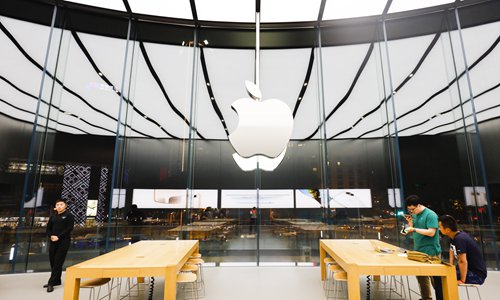It's a story full of twists and turns. Apple's contract manufacturing partner Foxconn has refuted reports that it has scrapped a $5 billion investment plan in India, which is what India's Industries Minister Subhash Desai told the media.

Customers try out iPhones at an Apple store in Nanjing, East China's Jiangsu Province. (File photo: VCG)
Who is telling the truth ... or is it just a misunderstanding? At the very least, the situation suggests difficulties for Apple to shift its production from China to India.
According to media reports, Apple has been committed to making India one of its major manufacturing centers, and it's really paid off in the past year. In October 2019, Apple started selling iPhone XRs assembled in Foxconn's Chennai factory.
However, despite all Apple's efforts to show how much it seems to value India, it seems pretty certain that India won't be the next China. Apple's plan to produce in India appears more like a response to local import duties and the US-China trade war. The number of iPhones that Foxconn produced or assembled in India was tiny compared with the global demand. According to a Reuters report in August 2019, production from Apple's contract factories in India may be only enough to meet local demand, while the company added more factories in China than outside with Foxconn alone expanding from 19 locations in 2015 to 29 in 2019, according to Apple's data.
A report by Fortune magazine estimated in June 2019 that Apple may only be able to "move 5 to 7 percent of its iPhone production to India "in a best-case scenario over the next year." At least for Apple, India's disadvantages in manufacturing are obvious, namely a weak supply chain and poor infrastructure.
In China, most components are made locally and close to Foxconn's factories, while in India, Foxconn had to assemble most iPhones with imported components. Reuters data indicated that Apple's dependence on China is deepening in terms of its supply chain, with 47.6 percent of the supplier locations in China in 2019, up from 44.9 percent in 2015.
In the meantime, considering India's underdeveloped infrastructure, the logistics of imported components must not be easy. Since improving roads and railways takes time and money, the situation is unlikely to change in the years to come.
Moreover, while India has plenty of cheap labor, it's unclear whether it can supply skilled workers to make consumer electronics.
It's been said that 2020 could be Apple's breakout year in India, but it should be noted that China remains the US company's third-largest revenue contributor, with $44 billion for fiscal 2019, indicating Apple's large consumer base in China. By comparison, Apple's revenue in India was a mere $1.5 billion during the same period.
Despite all these disadvantages, Apple and Foxconn still must see India as its alternative production base due in large part to the US-China trade war, which has led to upheaval in global supply chains. But trade war brings losses to all parties and India is no exception given its weak manufacturing foundation.


